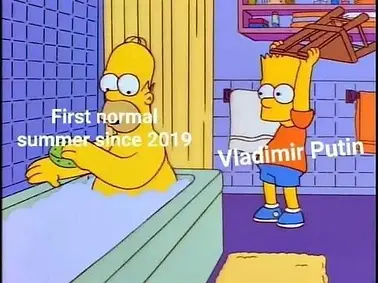
Discourse Analysis 4: critical analysis of memes
Introduction:
In this specific Discourse Analysis the primary category that will be discussed will be the placement of memes within discourse and what is their role in our modern society. Memes can be viewed as funny images found through various social media platform that primarily target young people who are prone to use those platforms. At first impact their crucial role is to entertain and amuse the audience, but as the analysis of these meticulously crafted images goes deeper their true purpose rises as they conform to specific dictations of their society and culture, which surrounds them. In this specific Discourse Analysis I will study three different memes that fall into the category of culture-centred criticism and are linked to either the war between Rusiia and Ukraine or the figure of Vladmir Putin.
Meme 1
First Covid now this?

In this meme, the recurring image of Homer Simpson bathing peacefully while his son Bart, sneaks behind him holding a chair, most likely with the intention of slaming it into his father, is an excellent example of an imminent threat, unbeknownst to a specific audience. The writing examines not only the threat of war but the previous world crisis of the Coronavirus and how without a skip of a heartbeat the world as fallen into its usual "rule of the strongest" and war erupts wherever there is peace. The cultural factor that can be shared, even in the slightest ideal around the world, is the subsequent threat that is lurking in the close future. In this case the Russia-Ukraine conflict that happened immediately after the coronavirus pandemic was controlled.
Meme 2
War Trophy
This second meme portrays a picture of Putin giving a lecture or somekind of talkative debate where the bold writing at the corners of the image suggest the drastic views on how the Russian army, dictated under Putin's power, views Ukraine as a reward that is to be given like a slice of pie. The ironic take on how an entire culture, society, country, and the innocent people living within them are dealt like a pile of cards, or in this case a piece of case, by a singular man. The "slice of Ukraine" can be also be seen as a part of their unique identity, that is worthless to the Russian people, but regardless it is taken away and spread among the invaders who not only are indifferent to the situation but are entirely forced into the conflict because of their head of government.

Meme 3
Significance of a "meme"

The third meme I chose, could be the most impactful, especially when the meme is paired with the description shown under it. The picture shows Putin being cuddled by Hitler and reassured that his actions are entirely correct, because in the eyes of madness everyone can be deemed a genius. the description posted by the official Ukrainian twitter account reminds the readers that as funny and amusing memes can be, it is they're reality and every image no matter with what caption it is shown to the outside world is taken from real events that are currently happening in our world. the Ukrainian culture of today is trying to survive the authoritarian control of the Russian dictatorship controlled by Putin and the many large figures that correlate with the term "dictator".
Reflection:
As said before the analysis of memes opened my eyes to the world they showcase using either humour, irony, or any other form of comedic relief to ensure entertainment with their audience, but by using a culture-centred lens to critically analyze their surrounding impact on discourse really makes the viewer understand the depth of specific categories of memes and how they can play a harmful role or a very optimistic one in today's society. The grand range of cultures that possess this ability to enjoy and laugh about one another, especially when it comes to a subjective reflection within their own culture, is immense and highly interventionist, for it calls upon both the producers and the audience of discourse to engage in a sensitive manner to cultural differences. Using this specific genre of "war memes" that act on the difference of culture between the two opposing countries makes the sensitivity, unity, and harmony of this culture based genre of discourse a very complicated subject, as it differs from the usual path of accepting and showing respect to a different culture and instead diminishes it completely. Mind you that this is the exact reason I used a language and imagery that would focus strongly on the figure of Vladmir Putin and the Russian government as the enemy and not the entirety of the Russia.
